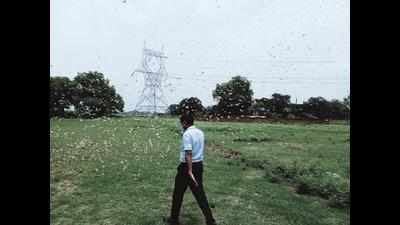- News
- City News
- varanasi News
- Swarms of locusts enter dist from Mirzapur, Jaunpur
Trending
This story is from June 26, 2020
Swarms of locusts enter dist from Mirzapur, Jaunpur
Varanasi: Locust swarms have entered several villages of the district on Thursday. Besides, swarms have also entered some areas of Azamgarh and Bhadohi districts. Earlier, in the last week of May, swarms had hit Mirzapur district. The local administrations have geared up to ward off locusts by engaging spraying teams and fire brigade.
Giving details, officials said two swarms of locusts, which entered the district from Mirzapur side, were seen in Chiraigaon block and Raja Talab tehsil on Thursday.Besides, a third swarm of locusts, which came from Jaunpur side, was seen in Pindra tehsil.
Varanasi district magistrate Kaushal Raj Sharma said that the administration has made all the necessary arrangement to tackle the situation if the locust swarms settle anywhere in the district at night. The fire brigade, manual spray pumps for spraying insecticide have been put on ready mode to start operation after finding the locations of the insects at night. All the SDMs, BDOs and officials of agriculture department, and gram pradhans have been engaged in tracing the location of locust swarms.
Meanwhile, swarms of locusts also entered Azamgarh district from Jaunpur. According to the agricultural department officials, the swarms of the insects were seen moving towards Deedarganj, Sikraur Sahbari and Sarai Mir. The teams of agriculture department are keeping a close eye on their movements.
Varanasi and Chandauli districts had alerted the farmers and government staff to take necessary measures for its control.
The DM had also given some tips to the farmers on how to handle the situation. He appealed the farmers to remain on vigil and inform the district authorities immediately if the problem occurs. The locust swarms can be diverted by making noise. The sandy soil is fit for the breeding of locust, hence the field of sandy soil should be tilled or filled with water to evade the problem. The farmers were advised to use prescribed pesticide to save the crops.
The Central government has also taken measures to control the locusts. According to a report of the department of agriculture and farmers’ welfare (DAC&FW), control operations are being run in the affected states including Rajasthan, Punjab, Gujarat and Madhya Pradesh. For effective control of locusts beyond scheduled desert areas, temporary control camps have been established in Ajmer, Chittorgarh and Dausa in Rajasthan; Mandsaur, Ujjain and Shivpuri in Madhya Pradesh and Jhansi in Uttar Pradesh.
According to the report, usually the locust swarms enter the Scheduled Desert Area of India through Pakistan for summer breeding in the month of June/July with the advent of monsoon. This year, however the incursions of locust hoppers and pink swarms have been reported much earlier because of presence of residual population of locusts in Pakistan which they couldn’t control last season.
Giving details, officials said two swarms of locusts, which entered the district from Mirzapur side, were seen in Chiraigaon block and Raja Talab tehsil on Thursday.Besides, a third swarm of locusts, which came from Jaunpur side, was seen in Pindra tehsil.
Varanasi district magistrate Kaushal Raj Sharma said that the administration has made all the necessary arrangement to tackle the situation if the locust swarms settle anywhere in the district at night. The fire brigade, manual spray pumps for spraying insecticide have been put on ready mode to start operation after finding the locations of the insects at night. All the SDMs, BDOs and officials of agriculture department, and gram pradhans have been engaged in tracing the location of locust swarms.
Meanwhile, swarms of locusts also entered Azamgarh district from Jaunpur. According to the agricultural department officials, the swarms of the insects were seen moving towards Deedarganj, Sikraur Sahbari and Sarai Mir. The teams of agriculture department are keeping a close eye on their movements.
Earlier, the swarms of locusts had reached Kusiara village in Halia area of Mirzapur district on May 28. The district administration had taken preventive measures in view of locusts’ attack.
Varanasi and Chandauli districts had alerted the farmers and government staff to take necessary measures for its control.
The DM had also given some tips to the farmers on how to handle the situation. He appealed the farmers to remain on vigil and inform the district authorities immediately if the problem occurs. The locust swarms can be diverted by making noise. The sandy soil is fit for the breeding of locust, hence the field of sandy soil should be tilled or filled with water to evade the problem. The farmers were advised to use prescribed pesticide to save the crops.
The Central government has also taken measures to control the locusts. According to a report of the department of agriculture and farmers’ welfare (DAC&FW), control operations are being run in the affected states including Rajasthan, Punjab, Gujarat and Madhya Pradesh. For effective control of locusts beyond scheduled desert areas, temporary control camps have been established in Ajmer, Chittorgarh and Dausa in Rajasthan; Mandsaur, Ujjain and Shivpuri in Madhya Pradesh and Jhansi in Uttar Pradesh.
According to the report, usually the locust swarms enter the Scheduled Desert Area of India through Pakistan for summer breeding in the month of June/July with the advent of monsoon. This year, however the incursions of locust hoppers and pink swarms have been reported much earlier because of presence of residual population of locusts in Pakistan which they couldn’t control last season.
End of Article
FOLLOW US ON SOCIAL MEDIA












